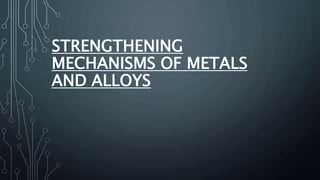
Strengthening Mechanisms of Metals and alloys
- 1. STRENGTHENING MECHANISMS OF METALS AND ALLOYS
- 2. WHY STRENGTHENING IS NEEDED… • In pure state of some metals, the strength is not sufficient for specific engineering works. • All the metals have movable internal dislocations due to stresses associated with the forming process. • Movement of these dislocations cause plastic deformation. • By avoiding the movement of the dislocations, metals can be strengthen. • Variation of deformation process with temperatures • T > 0.5 Tm – Hot working • T ~ 0.5 Tm – Warm working • T < 0.5 Tm – Cold working Tm :absolute melting point of the metal.
- 3. MAIN TYPES OF STRENGTHENING METHODS • Grain-size reduction • Solid-solution alloying • Strain hardening (work hardening or cold working) • Annealing of deformed metals
- 4. GRAIN-SIZE REDUCTION • Grains are not well oriented in polycrystalline materials as single crystal materials. Grain s • Barrier to dislocation movement. (changes or stops the path of the dislocation)
- 5. • By increasing the number of grains, the no of barriers to the dislocation also increases. Therefore by reducing grain size, the no of barriers can be increased. • High-angle grain boundaries block slip and increase strength of the material. Because the pressure of the slip is stopped by exerting much force by large angles. σYP -Yeild strength σo,k -constants for a particular material d - is the average grain diameter Hall-Petch equation :
- 6. • Grain size (d) varying parameters : Rate of solidification. Appropriate heat treatment. • According to the graph, The yield strength is increased with the reduction of grain size. Because of reduction, the number of grains are increased.
- 7. SOLID-SOLUTION ALLOYING • The technique works by adding atoms of one element (the alloying element) to the crystalline lattice of another element (the base metal), forming a solid solution.• Substitutional • Distributed impurity atoms are similar in size of the host metal atoms. • Maintain the ductility of the initial pure metal. • Interstitial • Some of interstices in metal structure occupied by smaller atoms. • More rigid than the primary metal.
- 8. • Small impurities mostly concentrate near to act as a barrier to the dislocation. • These impurities act as an obstacles to moving dislocations and minimize the propagation of the dislocations. • This increase the yield strength of the material.
- 9. • Solid solution strengthening depends on: Concentration of solute atoms. Shear modulus of solute atoms. Size of solute atoms. Valency of solute atoms (for ionic materials).
- 10. STRENGTHENING BY STRAIN HARDENING( WORK HARDENING OR COLD WORKING) • Plastic deformation of ductile materials increase the strength of the material at very low temperature than its’ melting point. • Strengthening of a metal or polymer by plastic deformation is called as work hardening or strain hardening. • This strengthening occurs because of dislocations movements and dislocation generation within the crystal structure of the material. • The reason for strain hardening is the increase of dislocation density with plastic deformation.
- 11. • The average distance between dislocations decreases and dislocations start blocking the motion of each other. €e -recoverable elastic strain €p -inelastic strain Σ0 -stress at initial yield Σy -stress at new yield Σ0<Σy A0 -initial cross sectional area Ad -new cross sectional area CW -Cold work percentage
- 12. • In addition to maximizing dislocation density, work hardening changes the following parameters of the material. • Hardness increase • Yield strength increases • Ductility decreases (material becomes more brittle) • Grain become directional • Conducting temperature is very low compared to melting point temperature. (~1/3 of melting temperature)
- 13. ANNEALING OF DEFORMED METALS • After cold working, most of metals are in high energy state. • For restoration to the initial state of the metal, annealing process can be carried out by heat treating. • Ductility is very low after the cold working, but hardness is higher. • Main steps in annealing, • Recovery • Recrystallization • Grain growth
- 14. •Recovery • The strain fields around dislocations cause them to interact (exert force on each other). If dislocations are in the same plane, they attract/annihilate when they have opposite signs. Therefore dislocation cancel out and their contribution to the stored energy is removed. • Steps of recovery • Heating • Increased diffusion • Enhanced dislocation motion • Decrease in dislocation density by annihilation • Relieve of the internal strain energy • Recovered material
- 15. •Recrystallization • Even after recovery, the grains can be strained. These strained grains of cold-worked metal can be replaced, upon heating, by strain-free grains with low density of dislocations. • Simply the regeneration of new grains can be observed. • Recrystallization temperature: The temperature at which the process is complete in one hour. It is typically 1/3 to
- 16. •Grain growth • Growth of the generated grains in recrystallization state, by maintaining at annealing temperature, then further grain growth occurs. • Driving force causes reduction of the total grain boundary area and, hence, Big grains grow at the expense of the small ones. • Boundary motion occurs by short range diffusion of atoms across the grain boundary.
- 17. • Change of properties with the steps of the annealing:
- 18. END
